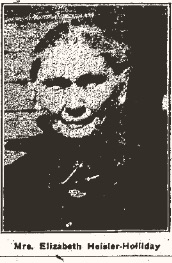Mapleton Press HARDSHIPS OF PIONEERS EXAGGERATED, SAYS MRS. HOLLIDAY, HERE 66 YEARS. Those who say that the pioneers of the prairies suffered untold hardships are mostly the younger generation. So says Mrs. Elizabeth Heisler-Holliday, who was among the very first women to reach Mapleton—in a period when Indians still had their tepees here and when the white man was in the minority. That was 66 years ago. “We had enough to eat those days and we had many good times,” said Mrs. Holliday. I think that lots of people today are undergoing more hardships than the early settlers did.” Whether Mrs. Holliday is the oldest living settler in Mapleton is not definitely known, but the fact remains that she is a real pioneer. Born in 1843. Mrs. Holliday boasts of several trips in covered wagons. One year after reaching Iowa, she returned to Indiana with an uncle and his family on a visit. She remained in Indiana until 1859 and then returned to Panora with friends. All these trips were made in a covered wagon. While visiting in Indiana, her father, Thomas Maynard, had driven a yoke of oxen across the plains to Mapleton. Upon her return to Panora, her father met her with the oxen and took her to the new country, the Maple valley. Married in 1861. The family first lived in what was then “Old Mapleton.” Their first house was a sod structure, which is these days considered a luxury. Elizabeth Maynard, as she was known before her marriage, became the wife of Henry Heisler, January 13, 1861. Their’s was the first marriage in Cooper township, according to old records. The couple settled on the place now occupied by Vern Vanderbur, about two miles north of Mapleton. There they lived for 25 years. The young husband decided to build a model home for his family, and since lumber was not available here, he drove to Ames, the nearest railway point, for his materials. He made several trips for lumber in the fall of 1866 and the spring of 1867. When completed, the house was one of the finest in the prairie territory. Donated Cemetery. The family lived on the farm for 25 years. They sold the place and moved to the farm now occupied by Jesse Uhl, three miles northwest of Mapleton. After living there 29 years they moved to Mapleton. Mr. Heisler died October 11, 1891, and on November 25, 1897, Mrs. Heisler married Elias Holliday, who passed away July 28, 1916. Worried by Indians. Mrs. Holliday feels proud of the fact that she has 42 grandchildren and 28 great grandchildren. Mrs. Holliday’s recollections of the early days would fill a book. She well remembers the Indian scares. When the family first came here, the red man felt hurt because of the white man’s encroachment upon his domain. Although the early setters were often worried by him, the Indian never molested the pioneers near Mapleton, said Mrs. Holliday. Bill Wiltsey operated a tavern in “Old Mapleton” in those days. It was located just across the Maple river, west of Mapleton, near what is now the Lamp farm. Wiltsey’s house was a stopping place for travelers and letter carriers. Whenever rumors of Indian uprisings spread, the few early settlers would seek refuge at the tavern, said Mrs. Holliday. January 1, 1864, was the coldest day Iowa has ever known, according to Mrs. Holliday. “I well remember the day,” she said. “It was so cold that one could scarcely go outside without freezing. Blizzards were not unusual then. Our winters now are mild in comparison.” Traveling Cheaper Then. Although approaching her 83rd birthday, Mrs. Holliday is in good health. She reads much, her hearing is excellent and her mind unusually active for a person her age. Her son, Bert, gives her much aid in her housework in her declining days, which are pleasant and complete with the knowledge that she has lived in an age of far-reaching progress and civilization. ~An individual photo of Mrs. Holliday accompanied this pioneer feature article. Mrs. Elizabeth Heisler-Holliday, nee' Maynard Her Obituary posted on this website
~Transcription by L. Ziemann, Monona County Coordinator, Oct 2019 | ||
